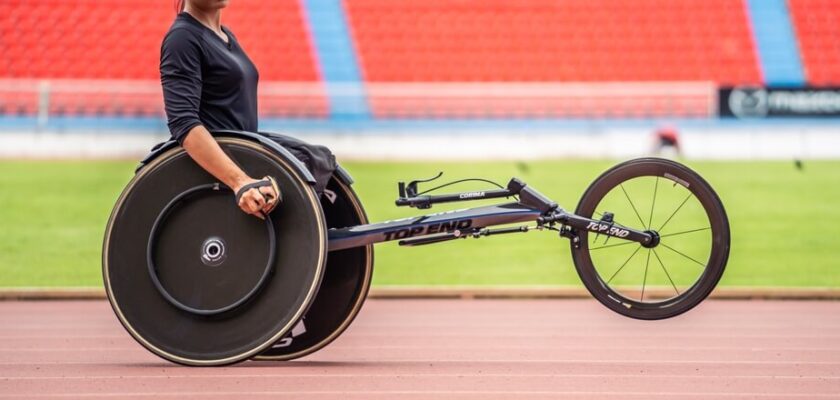Paralympic triathlon is a high-endurance sport that combines swimming, cycling and running, adapted for athletes with disabilities. The International Triathlon Union (ITU) and the International Paralympic Committee (IPC) regulate the sport and have created the rules of paralympic triathlon to ensure that competitions are fair and safe for all participants.
But what are these rules? What do you need to do to become a Paralympic triathlon champion?
These are the answers we provide throughout this guide. Read on and clear up your doubts.
Open your Betano account and get up to 1,000 reais in bonuses.
PIX payments, live games and super odds!
Click here to open your account!
Paralympic triathlon rules about its disciplines
First of all, in order to understand the rules of Paralympic tri athlon, it’s essential to master the sport’s categories.
In the sport, athletes are classified according to the type and degree of disability, ensuring a fairer and more competitive competition for all athletes.
In this sense, the main categories are:
- PTWC (Paratriathlon in Wheelchair): Athletes who compete in wheelchairs. Includes categories for those with severe disabilities in the lower limbs and/or trunk.
- PTS2 to PTS5 (Standing Paratriathlon): athletes with physical disabilities who can compete standing. Classifications range from PTS2 (more severe disabilities) to PTS5 (less severe disabilities).
- PTVI (Paratriathlon for the Visually Impaired): visually impaired athletes compete with guides.
Now that you understand how the athletes are divided, let’s move on to the rules of paralympic triathlon.
Paralympic triathlon rules: information and general rules
To make things easier to understand, we’ve separated the rules of Paralympic triathlon into groups and themes.
1. Competition format
The Paralympic triathlon format involves three disciplines:
- Swimming: 750 meters.
- Cycling: 20 km.
- Running: 5 km.
Two transition areas (T1 and T2) are used to change equipment between disciplines, from Paralympic swimming to cycling and from cycling to running.
The length of the routes can also vary, depending on the competition, but they generally respect the values presented above.
Read also: All about Paralympic cycling: rules, disciplines and classes [Updated]
2. Category-specific paralympic triathlon rules
As you might expect, each category of Paralympic triathlon has its own set of rules, which adapt to the demands of each athlete. Check them out!
PTWC (wheelchair athletes)
- Equipment: adapted wheelchairs are allowed (of course) for running and handcycles for cycling.
- Transition:assistance is allowed in the transition area between one sport and another, helping the athlete in and out of the wheelchair and handcycle.
- Penalties: each tournament has its own set of rules for transitions and external support. That’s why it’s essential to be aware of them, and avoid penalties for mistakes at this point.

PTS2 to PTS5 (athletes with physical disabilities who can compete standing up)
- Equipment: in this category it is permitted to use prostheses or other assistive devices as required.
- Transition: limited assistance is allowed in the transition area.
- Penalties: occur when the athlete or one of their assistants infringes specific rules for the proper use of assistive devices and prostheses during all phases of the competition.
PTVI (people with visual impairments)
- Guides: visually impaired athletes must compete with a guide, who must be at the athlete’s side throughout the competition.
- Equipment: it is necessary to use a rope to connect the athlete and their guide during swimming. In cycling, the bicycle model is the tandem, which fits two people.
- Transition: the guide can provide assistance at transitions.
- Penalties: there are specific rules for the interaction between the athlete and the guide, including maximum distances allowed between them.
Read also: Blind soccer rules: how does the sport adapt to the players’ reality?
3. Violation of rules
Penalties range from warnings to disqualifications, depending on the seriousness of the infraction.
They can be applied for violations of safety rules, unsportsmanlike conduct, or improper use of equipment, as well as assists that fall outside the norms, especially during transitions.
It’s worth noting that penalties are decided by race officials and can be challenged by athletes through an appeals process.
Paralympic triathlon rules on the winner
But how do you win a Paralympic triathlon race? The answer is simpler than you might think: the winner is the athlete who completes the race course in the shortest total time.
For the “Sprint” format with distances of 750m swimming, 20km cycling and 5km running, the average finishing time for the best athletes varies between 1 hour and 1 hour 30 minutes .
In this format, it’s important to be aware of the Paralympic triathlon rules for penalties, which can interfere with the result, increasing the athletes’ time, for example.
In short, the winner is the athlete who crosses the finish line first, having completed the three disciplines (swimming, cycling and running) and the two transitions (T1 and T2) in the shortest total time.
In addition, the winners are declared within their respective classification categories, which take into account the different types and degrees of disability (PTWC, PTS2-PTS5, PTVI), as we mentioned above.
In the event of a tie, photo-finish technology may be used to determine the winner, specific ITU rules or the regulations of the particular event.
However, athletes’ final times may be adjusted by penalties applied during the race, which can occur for unsportsmanlike conduct, safety violations, or improper use of equipment.
We hope this guide to the rules of Paralympic triathlon has helped you understand more about the sport and inspired you to cheer on our athletes or even start training. In both cases, as a fan or athlete, you only stand to gain!
Open your Betano account and get up to 1,000 reais in bonuses.
PIX payments, live games and super odds!



